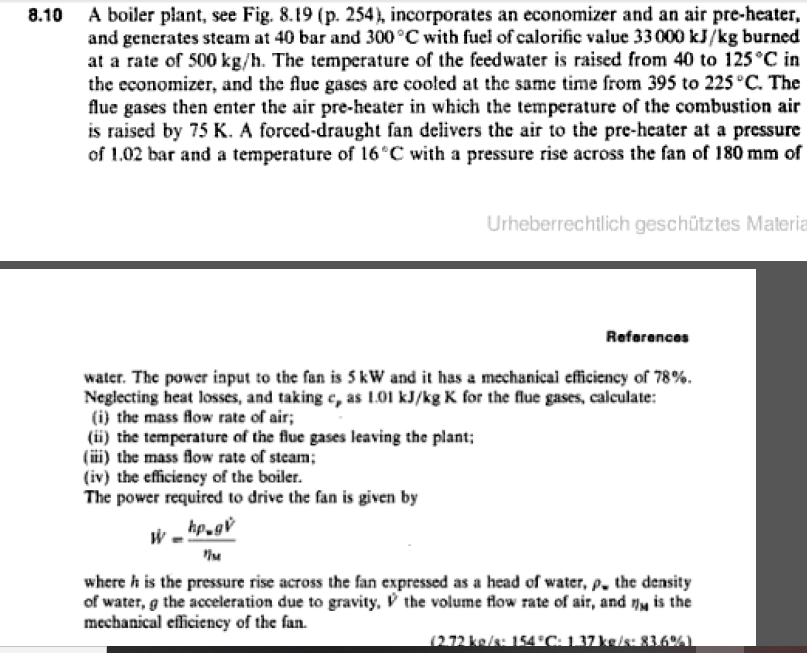A boiler plant, see Fig. 8.19 (p. 254), incorporates an economizer and an air pre-heater, and generates steam at 40 bar and 300°C with fuel of calorific value 33000 kJ/kg burned at a rate of 500 kg/h. The temperature of the feedwater is raised from 40 to 125°C in the economizer, and the flue gases are cooled at the same time from 395 to 225 °C. The flue gases then enter the air pre-heater in which the temperature of the combustion air is raised by 75 K. A forced-draught fan delivers the air to the pre-heater at a pressure of 1.02 bar and a temperature of 16°C with a pressure rise across the fan of 180 mm of Urheberrechtlich geschütztes Materia Reforences water. The power input to the fan is 5 kW and it has a mechanical efficiency of 78%. Neglecting heat losses, and taking ce, as 1.01 kJ/kg K for the flue gases, calculate: (i) the mass flow rate of air; (ii) the temperature of the flue gases leaving the plant; (ii) the mass flow rate of steam; (iv) the efficiency of the boiler. The power required to drive the fan is given by hp.gV where h is the pressure rise across the fan expressed as a head of water, p, the density of water, g the acceleration due to gravity, V the volume flow rate of air, and ŋm is the mechanical efficiency of the fan.
A boiler plant, see Fig. 8.19 (p. 254), incorporates an economizer and an air pre-heater, and generates steam at 40 bar and 300°C with fuel of calorific value 33000 kJ/kg burned at a rate of 500 kg/h. The temperature of the feedwater is raised from 40 to 125°C in the economizer, and the flue gases are cooled at the same time from 395 to 225 °C. The flue gases then enter the air pre-heater in which the temperature of the combustion air is raised by 75 K. A forced-draught fan delivers the air to the pre-heater at a pressure of 1.02 bar and a temperature of 16°C with a pressure rise across the fan of 180 mm of Urheberrechtlich geschütztes Materia Reforences water. The power input to the fan is 5 kW and it has a mechanical efficiency of 78%. Neglecting heat losses, and taking ce, as 1.01 kJ/kg K for the flue gases, calculate: (i) the mass flow rate of air; (ii) the temperature of the flue gases leaving the plant; (ii) the mass flow rate of steam; (iv) the efficiency of the boiler. The power required to drive the fan is given by hp.gV where h is the pressure rise across the fan expressed as a head of water, p, the density of water, g the acceleration due to gravity, V the volume flow rate of air, and ŋm is the mechanical efficiency of the fan.
Refrigeration and Air Conditioning Technology (MindTap Course List)
8th Edition
ISBN:9781305578296
Author:John Tomczyk, Eugene Silberstein, Bill Whitman, Bill Johnson
Publisher:John Tomczyk, Eugene Silberstein, Bill Whitman, Bill Johnson
Chapter45: Domestic Refrigerators And Freezers
Section: Chapter Questions
Problem 12RQ: Refrigerators currently being manufactured in the United States are using______as their refrigerant.
Related questions
Question
solve the question in the picture

Transcribed Image Text:A boiler plant, see Fig. 8.19 (p. 254), incorporates an economizer and an air pre-heater,
and generates steam at 40 bar and 300°C with fuel of calorific value 33 000 kJ/kg burned
at a rate of 500 kg/h. The temperature of the feedwater is raised from 40 to 125°C in
the economizer, and the flue gases are cooled at the same time from 395 to 225 °C. The
flue gases then enter the air pre-heater in which the temperature of the combustion air
is raised by 75 K. A forced-draught fan delivers thc air to the pre-hcater at a pressure
of 1.02 bar and a temperature of 16 C with a pressure rise across the fan of 180 mm of
8.10
Urheberrechtlich geschütztes Materia
References
water. The power input to the fan is 5 kW and it has a mechanical efficiency of 78%.
Neglecting heat losses, and taking c, as 1.01 kJ/kg K for the flue gases, calculate:
(i) the mass flow rate of air;
(ii) the temperature of the flue gases leaving the plant;
(ii) the mass flow rate of steam;
(iv) the efficiency of the boiler.
The power required to drive the fan is given by
hp.gv
where h is the pressure rise across the fan expressed as a head of water, p. the density
of water, g the acceleration due to gravity, V the volume flow rate of air, and y is the
mechanical efficiency of the fan.
(2.72 ke/s: 154 C: 1.37 ke/s: 836%L
Expert Solution
This question has been solved!
Explore an expertly crafted, step-by-step solution for a thorough understanding of key concepts.
This is a popular solution!
Trending now
This is a popular solution!
Step by step
Solved in 4 steps with 1 images

Knowledge Booster
Learn more about
Need a deep-dive on the concept behind this application? Look no further. Learn more about this topic, mechanical-engineering and related others by exploring similar questions and additional content below.Recommended textbooks for you

Refrigeration and Air Conditioning Technology (Mi…
Mechanical Engineering
ISBN:
9781305578296
Author:
John Tomczyk, Eugene Silberstein, Bill Whitman, Bill Johnson
Publisher:
Cengage Learning

Refrigeration and Air Conditioning Technology (Mi…
Mechanical Engineering
ISBN:
9781305578296
Author:
John Tomczyk, Eugene Silberstein, Bill Whitman, Bill Johnson
Publisher:
Cengage Learning